Page 78 of 769
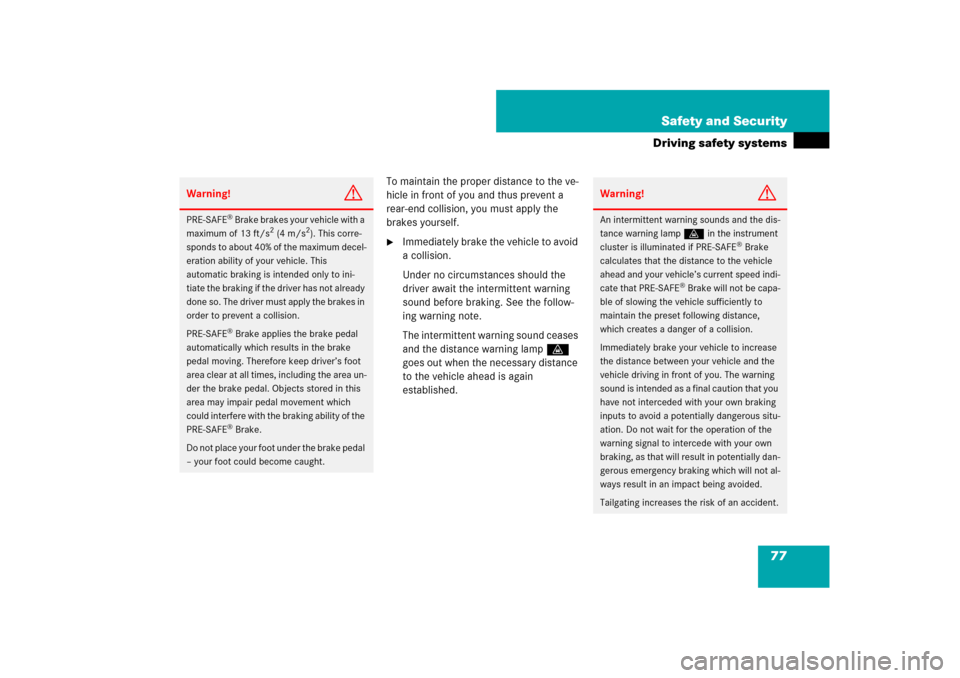
77 Safety and Security
Driving safety systems
To maintain the proper distance to the ve-
hicle in front of you and thus prevent a
rear-end collision, you must apply the
brakes yourself.�
Immediately brake the vehicle to avoid
a collision.
Under no circumstances should the
driver await the intermittent warning
sound before braking. See the follow-
ing warning note.
The intermittent warning sound ceases
and the distance warning lampl
goes out when the necessary distance
to the vehicle ahead is again
established.
Warning!
G
PRE-SAFE
® Brake brakes your vehicle with a
maximum of 13 ft/s
2 (4 m/s
2). This corre-
sponds to about 40% of the maximum decel-
eration ability of your vehicle. This
automatic braking is intended only to ini-
tiate the braking if the driver has not already
done so. The driver must apply the brakes in
order to prevent a collision.
PRE-SAFE
® Brake applies the brake pedal
automatically which results in the brake
pedal moving. Therefore keep driver’s foot
area clear at all times, including the area un-
der the brake pedal. Objects stored in this
area may impair pedal movement which
could interfere with the braking ability of the
PRE-SAFE® Brake.
Do not place your foot under the brake pedal
– your foot could become caught.
Warning!
G
An intermittent warning sounds and the dis-
tance warning lampl in the instrument
cluster is illuminated if PRE-SAFE
® Brake
calculates that the distance to the vehicle
ahead and your vehicle’s current speed indi-
cate that PRE-SAFE
® Brake will not be capa-
ble of slowing the vehicle sufficiently to
maintain the preset following distance,
which creates a danger of a collision.
Immediately brake your vehicle to increase
the distance between your vehicle and the
vehicle driving in front of you. The warning
sound is intended as a final caution that you
have not interceded with your own braking
inputs to avoid a potentially dangerous situ-
ation. Do not wait for the operation of the
warning signal to intercede with your own
braking, as that will result in potentially dan-
gerous emergency braking which will not al-
ways result in an impact being avoided.
Tailgating increases the risk of an accident.
Page 99 of 769
98 Control systemsCOMAND FM/AM radioSubmenu overviewWarning!
G
Please devote your attention first and fore-
most to the traffic situation you are in.
Before your journey, please familiarize your-
self with the radio functions.
Only use the COMAND when road and traffic
conditions permit you to do so. Otherwise
you could be involved in an accident in
which you or others could be injured.
i
The components and operating principles of
COMAND can be found on (
�page 83).
Radio
(except Weather Band)
Presets
(except Weather Band)
Channel
(only Weather Band)
FM or AM or WB
Sound
Station List
(in FM waveband only)
Autostore
Channel list
Switch to FM waveband
Treble
Save Station
Preset station list
Switch to AM waveband
Bass
Frequency Entry
Switch to Weather Band
Balance/Fader
Show Station Info
(in FM waveband only)
3D Sound
Page 100 of 769
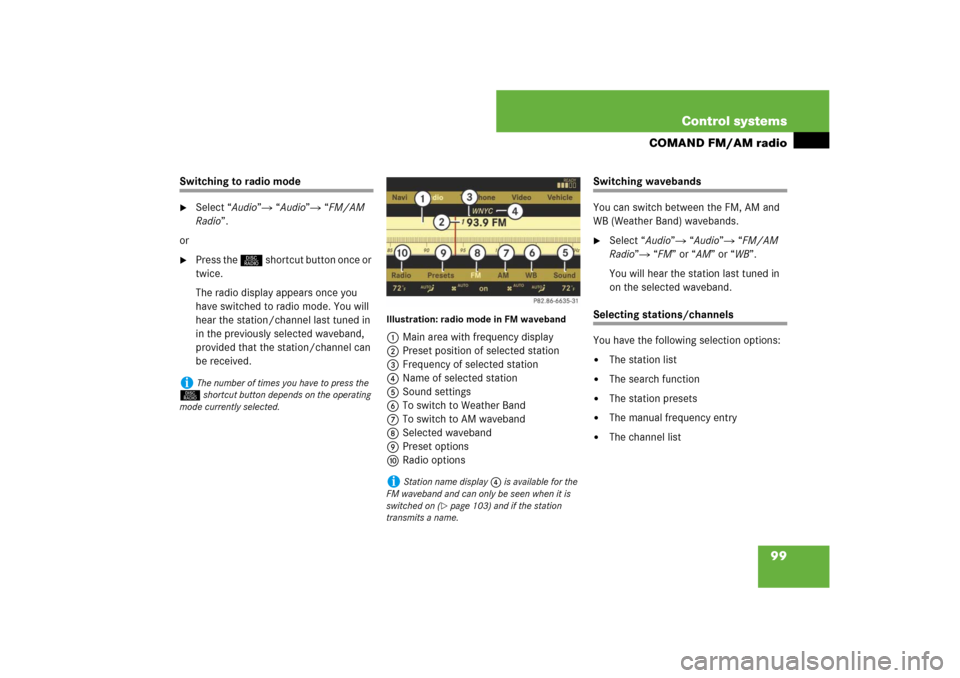
99 Control systems
COMAND FM/AM radio
Switching to radio mode �
Select “Audio”� “Audio”� “FM/AM
Radio”.
or
�
Press the M shortcut button once or
twice.
The radio display appears once you
have switched to radio mode. You will
hear the station/channel last tuned in
in the previously selected waveband,
provided that the station/channel can
be received.
Illustration: radio mode in FM waveband1Main area with frequency display
2Preset position of selected station
3Frequency of selected station
4Name of selected station
5Sound settings
6To switch to Weather Band
7To switch to AM waveband
8Selected waveband
9Preset options
aRadio options
Switching wavebands
You can switch between the FM, AM and
WB (Weather Band) wavebands.�
Select “Audio”� “Audio”� “FM/AM
Radio”� “FM” or “AM” or “WB”.
You will hear the station last tuned in
on the selected waveband.
Selecting stations/channels
You have the following selection options:�
The station list
�
The search function
�
The station presets
�
The manual frequency entry
�
The channel list
i
The number of times you have to press the
M shortcut button depends on the operating
mode currently selected.
i
Station name display 4 is available for the
FM waveband and can only be seen when it is
switched on (
�page 103) and if the station
transmits a name.
Page 101 of 769
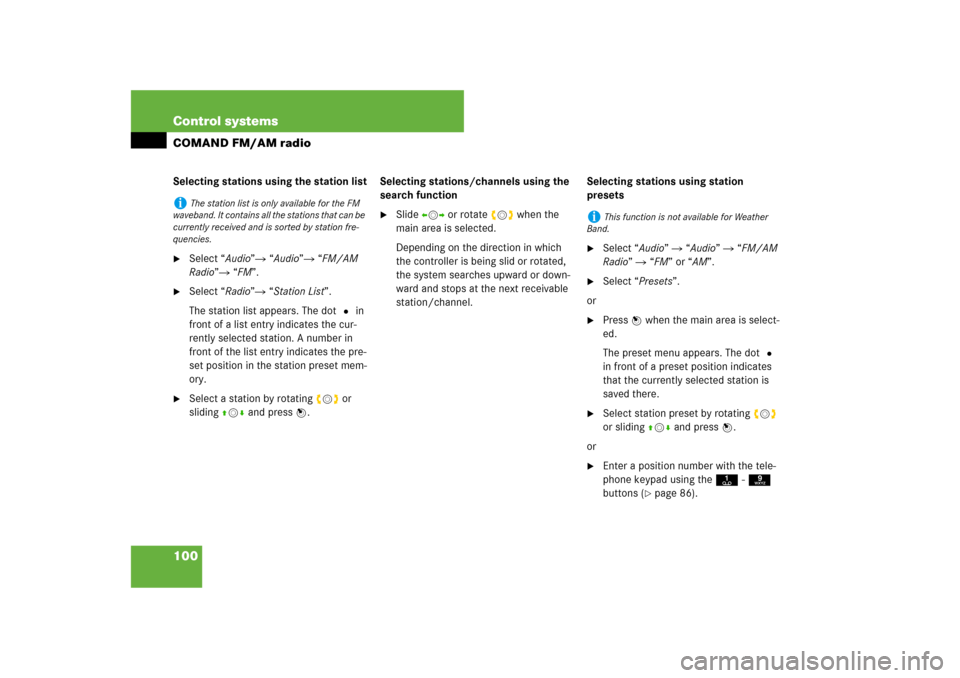
100 Control systemsCOMAND FM/AM radioSelecting stations using the station list�
Select “Audio”� “Audio”� “FM/AM
Radio”� “FM”.
�
Select “Radio”� “Station List”.
The station list appears. The dot R in
front of a list entry indicates the cur-
rently selected station. A number in
front of the list entry indicates the pre-
set position in the station preset mem-
ory.
�
Select a station by rotating ymz or
sliding qmr and press n.Selecting stations/channels using the
search function
�
Slide omp or rotate ymz when the
main area is selected.
Depending on the direction in which
the controller is being slid or rotated,
the system searches upward or down-
ward and stops at the next receivable
station/channel.Selecting stations using station
presets
�
Select “Audio” � “Audio” � “FM/AM
Radio” � “FM” or “AM”.
�
Select “Presets”.
or
�
Press n when the main area is select-
ed.
The preset menu appears. The dot R
in front of a preset position indicates
that the currently selected station is
saved there.
�
Select station preset by rotating ymz
or sliding qmr and press n.
or
�
Enter a position number with the tele-
phone keypad using the A- 9
buttons (
�page 86).
i
The station list is only available for the FM
waveband. It contains all the stations that can be
currently received and is sorted by station fre-
quencies.
i
This function is not available for Weather
Band.
Page 103 of 769
102 Control systemsCOMAND FM/AM radioSaving stations
You have the following options:�
Saving stations manually
�
Saving stations using Autostore
Saving stations manually
Option 1
�
Select “Audio” � “Audio” � “FM/AM
Radio” � “FM” or “AM”.
�
Select “Radio ”� “Save Station”.
Option 2
�
Press n when the main area is select-
ed.Option 3
�
Select “Audio” � “Audio” � “FM/AM
Radio” � “FM” or “AM”.
�
Select “Presets”.
All three of these will call up a station pre-
set screen. The dot R in front of a preset
position indicates that the currently select-
ed station is saved there.
�
Selecting a preset position:
Slideqmr or rotate ymz.Saving a station to a selected preset
position
If you have called up the station preset
screen using option 1:
�
Press n briefly.
In options 2 and 3:
�
Press and hold n until you hear a
signal.
The station is saved.
i
Twenty stations can be saved in each wave-
band except for Weather Band.
Page 104 of 769
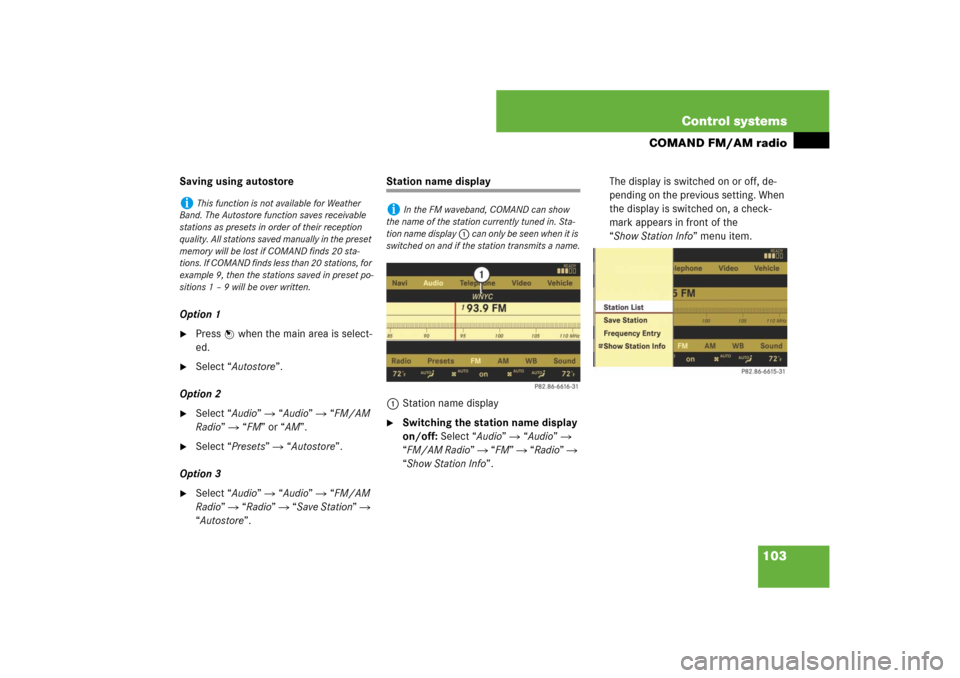
103 Control systems
COMAND FM/AM radio
Saving using autostore
Option 1�
Press n when the main area is select-
ed.
�
Select “Autostore”.
Option 2
�
Select “Audio” � “Audio” � “FM/AM
Radio” � “FM” or “AM”.
�
Select “Presets” � “Autostore”.
Option 3
�
Select “Audio” � “Audio” � “FM/AM
Radio” � “Radio” � “Save Station” �
“Autostore”.
Station name display
1Station name display�
Switching the station name display
on/off: Select “Audio” � “Audio” �
“FM/AM Radio” � “FM” � “Radio” �
“Show Station Info”.The display is switched on or off, de-
pending on the previous setting. When
the display is switched on, a check-
mark appears in front of the
“Show Station Info” menu item.
i
This function is not available for Weather
Band. The Autostore function saves receivable
stations as presets in order of their reception
quality. All stations saved manually in the preset
memory will be lost if COMAND finds 20 sta-
tions. If COMAND finds less than 20 stations, for
example 9, then the stations saved in preset po-
sitions 1 – 9 will be over written.
i
In the FM waveband, COMAND can show
the name of the station currently tuned in. Sta-
tion name display 1 can only be seen when it is
switched on and if the station transmits a name.
Page 105 of 769
104 Control systemsCOMAND satellite radioSubmenu overviewWarning!
G
Please devote your attention first and fore-
most to the traffic situation you are in.
Before your journey, please familiarize your-
self with the radio functions.
Only use the COMAND when road and traffic
conditions permit you to do so. Otherwise
you could be involved in an accident in
which you or others could be injured.
i
The components and operating principles of
COMAND can be found on (
�page 83).
Sat Radio
Presets
Info
Category
Sound
Channel List
Station presets
Show program info
Select category
Treble
Save Channel
Bass
Channel Entry
Balance/Fader
Service
3D Sound
Page 108 of 769
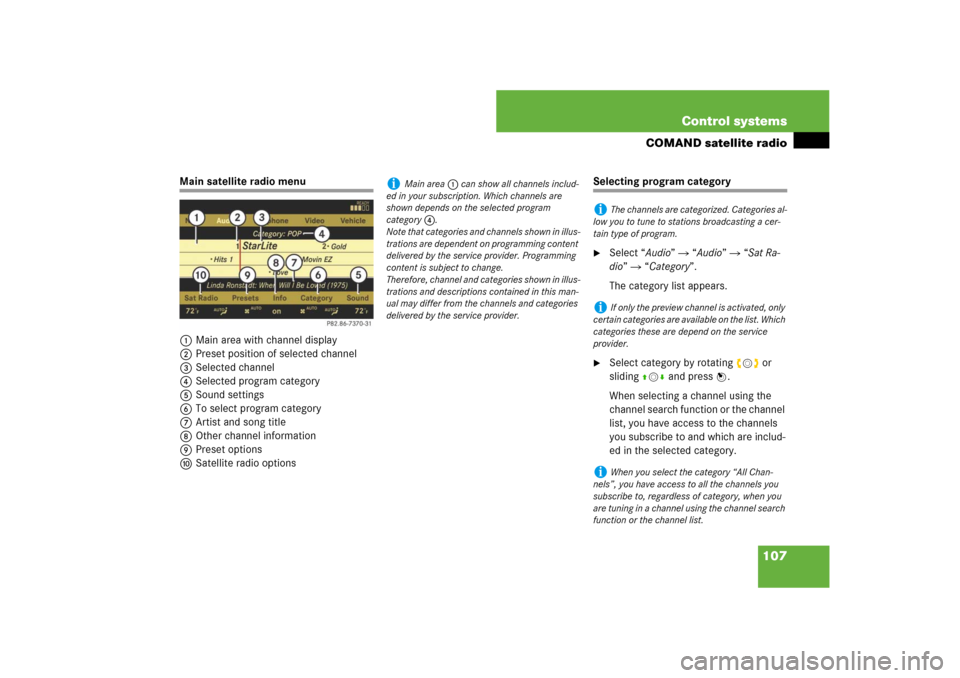
107 Control systems
COMAND satellite radio
Main satellite radio menu
1Main area with channel display
2Preset position of selected channel
3Selected channel
4Selected program category
5Sound settings
6To select program category
7Artist and song title
8Other channel information
9Preset options
aSatellite radio options
Selecting program category �
Select “Audio” � “Audio” � “Sat Ra-
dio” � “Category”.
The category list appears.
�
Select category by rotating ymz or
slidingqmr and press n.
When selecting a channel using the
channel search function or the channel
list, you have access to the channels
you subscribe to and which are includ-
ed in the selected category.
i
Main area1 can show all channels includ-
ed in your subscription. Which channels are
shown depends on the selected program
category4.
Note that categories and channels shown in illus-
trations are dependent on programming content
delivered by the service provider. Programming
content is subject to change.
Therefore, channel and categories shown in illus-
trations and descriptions contained in this man-
ual may differ from the channels and categories
delivered by the service provider.
i
The channels are categorized. Categories al-
low you to tune to stations broadcasting a cer-
tain type of program.
i
If only the preview channel is activated, only
certain categories are available on the list. Which
categories these are depend on the service
provider.
i
When you select the category “All Chan-
nels”, you have access to all the channels you
subscribe to, regardless of category, when you
are tuning in a channel using the channel search
function or the channel list.